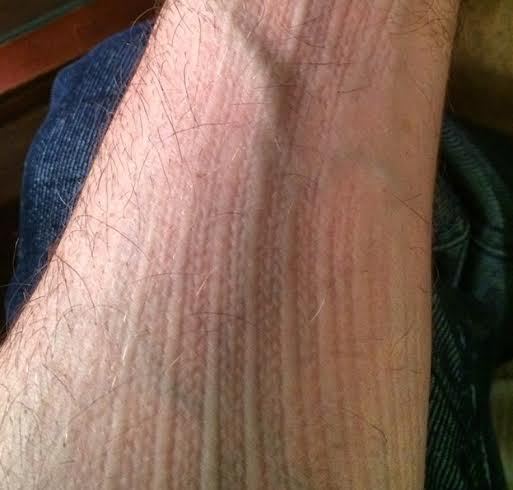Any series of essays written for Lyme Disease Awareness Month would be incomplete without addressing Lyme disease co-infections. Those who live with Lyme disease understand the role of coinfections; those who don’t know anything about Lyme other than what the news and federal public health agencies advise (”Check for ticks, and have a nice summer!”) without a doubt need their awareness raised. But before I get into coinfections, I want to talk about a coinciding disorder, mast cell activation syndrome, that is not infectious, but which is a nefarious gift of the Lyme-causing Borrelia burgdorferi bacteria that could last a lifetime. Some of what appears below is a bit technical, but if you know anyone who has been infected with Lyme disease, it could explain many otherwise inexplicable and life-affecting symptoms.
As discussed last week, the nature and even the existence of chronic Lyme disease are hotly debated because (in my opinion) not enough research is being done and despite what parties on either side of the debate say, not enough is known about how and why so many Lyme disease patients end up so ill for so long despite short-term antibiotic treatment.
However, all the way back in 1999, a study published in Infection and Immunity, the journal of the American Society for Microbiology, discussed how Borrelia burgdorferi spirochetes induce mast cell and cytokine release. An even earlier 1990 study from the journal Infection also observed this phenomenon in gerbils that were infected with human isolates of Borrelia burgdorferi. That study concluded:
Various numbers of plasma cells, eosinophils and high numbers of mast cells were also present. Three further animals which served as controls displayed no histological signs of inflammation in any organ system [...] The persistence of B. burgdorferi and the high number of organs involved with slight to severe signs of inflammation in this series can be compared to persistence and to the multiorgan involvement seen in human Lyme disease. Thus gerbils can serve as suitable experimental animals to study the pathogenesis of Lyme disease and the extent of organ damage caused by B. burgdorferi.
In short, the bacteria that cause Lyme disease also have been shown to trigger dysfunctional mast cell activation, and mast cell activation causes inflammation that can then bring about a great number of characteristic mild to life-threatening symptoms.
These symptoms are discussed below...but before we get there, it may help to understand exactly what mast cells are and how and why these cells function as they do, and how that may affect Lyme disease patients.
About Mast Cells
Eons ago—well, 20 years or so—in high-school biology classes, I learned about white blood cells. These are the guardians of our bodies. Comprised of a number of different types, including neutrophils, eosinophils, basophils, lymphocites and monocites, which are collectively known as leukocites (”leuko” meaning “white”), these white blood cells search out and destroy invaders. They are the Hungry Hungry Hippos of the immune system, and most infectious agents are nothing but pellets to be gobbled up. Yay, white blood cells!
Let’s watch human white blood cells search out and destroy invading bacteria and viruses.
Having come of age at the height of the HIV/AIDS crisis in the 80s and 90s, there was also a lot of talk on TV about T cells because a primary means by which to gauge the wellness of a person who carries the HIV virus is to count the T cells in his or her blood. If the T cell count is very low, the person’s shields are down and even bacteria, viruses and fungi that are always present in our bodies can become potentially deadly. T cells are manufactured in bone marrow.
But despite what I remember learning, and despite common understanding, the immune system is incredibly complex, as illustrated by this video.
Also manufactured in the bone marrow are a kind of cell I don’t recall ever having learned about in biology class—and it turns out that mine are all out of sorts. At 0:28 in the video above, fifth row, top column, you can see mast cells, whose jobs in the video are listed as “communicate, fight worms, cause inflammation, activate other cells.” The inflammation part becomes highly significant when mast cells release too many histamine and cytokines particles.
Mast cells—”multi-functional master cells” or mastocytes (scientists give us lots of formal and informal labels for everything)—are a primary aspect of our immune systems. They’re a bit complicated to understand, but this is how I picture them in my mind:

When we take capsule pills, we usually only notice the little oblong plastic-y encasement. But have you ever broken one open? (Of course you have!) Once broken, depending on the medication, hundreds of tiny little balls of different colors explode from inside, bouncing and skittering across every surface they hit, some of them rolling away never to be seen again. Mast cells are a lot like that.
Here’s a short video that shows how bee or snake venom would activate a mast cell. The little red balls inside of the cell membrane are histamine granules.
Mast cells contain a number of different tiny granulated chemicals, including histamine, heparin, cytokines, and others. When released, these are the agents of inflammation.
Most of us are familiar with the term antihistamine—Benadryl, Claritin, Allegra fall into this category of medication. Antihistamines help to inhibit mast cell degranulation, the process by which mast cells explode or dissolve and set their little chemical babies free. When we have seasonal or food allergies, what’s really happening is that some kind of substance that our bodies are exposed to holds the key that unlocks mast cells and causes them to degranulate.
Mast cell degranulation serves important roles in our well being. When histamines are released, for example, they cause inflammation, signaling the immune system to go into attack mode. That’s great when the body has to attack a foreign invader. It’s not so great when immune cells get their own “brain fog” (It’s an analogy; please don’t write to point out that cells don’t have brains.) and start attacking the body’s own native cells. And inflammation is meant to be a short-term battle mode, not a constant, chronic state of being. When there’s too much inflammation for too long, our bodies can’t operate as they are supposed to operate. Often, this type of dysfunction is due to a mast cell disorder.
Mast Cell Disorder Symptoms
When mast cells don’t function as they should, a wide range of allergic symptoms may occur, including flushing (skin that turns red or purple and becomes hot to the touch), itching, gastrointestinal problems including pain and acid reflux, and most dangerously anaphylaxis.

Typical symptoms of mast cell activation disorders.
As you can see above, mast cell activation disorder symptoms are almost as broad, multi-systemic and variable as Lyme disease symptoms. Some of the symptoms, particularly the neurologic, cardiovascular and systemic ones, can be indistinguishable from Lyme disease symptoms. Some are specific.
A lot of people who have Lyme disease complain that the internal nature of their symptoms makes it difficult for anyone to believe that they actually have an ailment. Lyme is known as an “invisible disease,” as many other chronic illnesses are. People who have co-occurring mast cell disorders have visible signs.
This is what happens to my arm when I wear a ribbed sweater:

Don’t think people don’t notice when your skin does that freaky texture-changing thing that octopuses do.
Not only that, but this is what happens if I very lightly scratch letters on my arm with a dull pencil:

Within five to 10 minutes, mast cells break apart where I scratched my skin, causing inflammation. The letters aren’t only red, but puffed up. This allergic phenomenon is known as dermatographic (”skin writing”) urticaria (hives). If I went to parties, it would be a neat party trick. It has been a neat (albeit disgusting to most people) office trick. But it’s not all fun and games. Shortly after the dermatographia appears, hives are triggered generally throughout the body, and I break out in red welts on my legs, my arms, etc.
These are symptoms fairly specific to mast cell disorders. Other unusual symptoms include flushing—skin turning red and hot in response to stimuli—and anaphylactic reactions to heat and exercise.
I am allergic to exercise now. If I break a sweat, I almost always break out in hives. That’s annoying. Much more troublingly, I also become dizzy and lightheaded and sometimes have difficulty breathing. That last one can be deadly—although I’ve lived with this for years and never knew it. I thought I was just out of shape and couldn’t catch my breath after 15 minutes of cardio.
But then beyond just mast cell symptoms, when I overheat in the summer, or from exercise, or even from a hot bath, I also sometimes get Parkinson’s-type tremors—sometimes extreme ones (Imagine Katharine Hepburn in a helicopter.)—double vision and other disturbing symptoms that go away when I cool down. If living with one chronic illness is a challenge, having more than one at once is, well, a greater challenge.
In any case, if you have dermatographia or break out in hives while you’re exercising, you should probably look into mast cell problems.
Same Symptoms, Different Disorders
There are two different types of mast cell disorder: mastocytosis and MCAS.
Mastocytosis is a disease in which for largely unknown reasons a patient has more mast cells than usual gathered in one or more organ systems. As a result, when mast cells are activated, the presence of a greater number of mast cells causes a greater release of histamines, cytokines, etc., and that causes greater inflammation than an average patient would experience. Mastocytosis is further broken down into three different types, cutaneous mastocytosis (primarily affecting skin), systemic mastocytosis (present in bone marrow), and mast cell sarcoma, which is very rare and as described in the medical journal Modern Pathology “bizarre.” More about mastocytosis.
Mast cell activation syndrome/disorders, or MCAS/MCAD, are very similar to mastocytosis but patients diagnosed with MCAS don’t fulfill all the criteria for a mastocytosis diagnosis. According to the Mastocytosis Society, three criteria must be met for an MCAS diagnosis:
- Specific symptoms, including flushing, itching, hives, low blood pressure and others;
- Increased serum tryptase (a simply blood test) levels or urine prostoglandin levels; and
- Improvement of symptoms when treated with antihistamine-based protocols.
A bone marrow biopsy is required to differentiate between mastocytosis and MCAS.
What About Lyme?
As discussed at the beginning of this article, decades-old research observes that mast cells can be triggered by Borrelia burgdorferi infections to flood the body with histamine, which then causes inflammation and MCAS symptoms. Since the criteria for diagnosing MCAS are relatively simple—unusual and easily identifiable symptoms, a blood or urine test, and response to antihistamine treatments—Lyme disease patients who have any characteristic symptoms may be able to find relief for many of them with proper diagnosis and over-the-counter antihistamine treatment that, to the relief of many Lyme patients, should not be controversial in any way.
I’ve simplified (and hopefully not too egregiously misstated) these complex and still little-understood conditions. Patients who believe they may have a mast cell disorder might want to print out this article, including this table of diagnostic criteria, and bring them to their doctors for consultation.
If you think you may have a mast cell activation disorder, invest the time in watching this video and the video below.
Find me (and say hi!) on Twitter @Artistlike.
If you’d like to see more in-depth research about Lyme and associated tickborne diseases, please consider supporting my work via Patreon.
